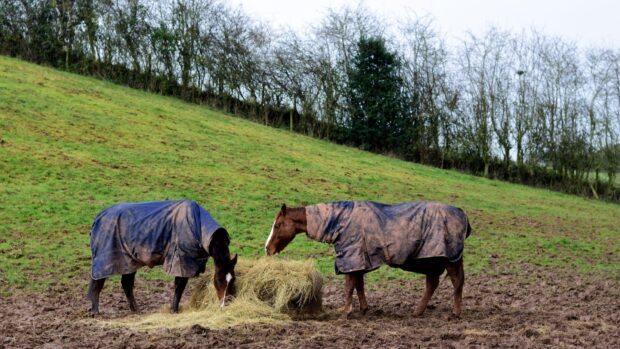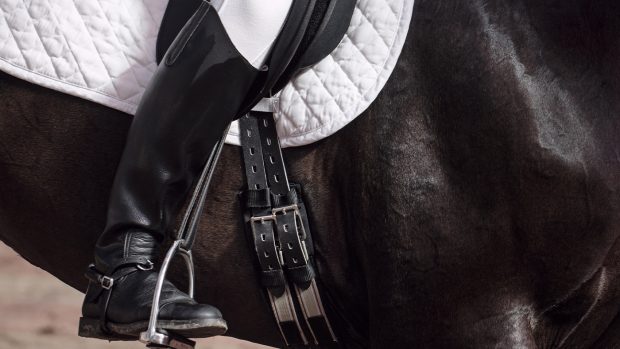Having horses involves owning a lot of kit and, after paying our essential bills, much of our hard-earned cash goes on tack and equipment for our equine partners. With the totals adding up to a considerable amount, it’s understandable that you’d want to protect your items from being damaged, lost or stolen. This is where tack insurance can come in.
Equine tack and equipment insurance is there to protect the various items and gear used for horse care, training, and competition. It helps cover the cost of replacing or repairing damaged, lost, or stolen items. Whether your horse has an extensive wardrobe of bespoke high-end items or your tackroom is filled with second-hand equipment that you’d be equally gutted to lose, tack insurance is a valuable option that some people completely overlook – until it’s too late.
Most standard horse insurance policies offer some level of cover for saddlery and tack, typically including loss, damage, or theft. This coverage can vary, with some policies offering a specific sum insured for tack and saddlery, and others covering it as part of a broader “death, theft, and straying” benefit. Some policies may also require specific security measures, such as locking tack away when not in use.
Equine tack and equipment insurance cover
When looking for insurance for tack and equipment, you need to decide what types of cover you need. Options include:
- Loss or theft: if your tack or equipment is stolen, or if it is lost due to circumstances beyond your control, this insurance can help cover the cost of replacement.
- Damage: coverage typically applies to damage caused by accidents, or even natural disasters. Some policies may also cover damage caused by the horse itself.
- Fire or natural disasters: some policies include coverage for damage caused by fires, floods, or other catastrophic events.
What items can be covered?
Tack is an obvious item that most of us want to be covered, but policies can be extended to include much more. Such items include saddles, bridles, reins, stirrups and other essential horse-riding gear.
Riding apparel including riding boots, helmets, gloves, and other protective gear used by the rider can also be included, as can stable equipment, for example, feed bins and water troughs.
In some cases, insurance can extend to cover such items as horse trailers or transportation gear used while traveling a horse and also competition gear.
In general, horse riding tack insurance policies may require that items exceeding a certain value are specifically listed on the policy. This is often the case for high-value items like saddles and certain bridles. The specific value threshold and whether all tack needs to be listed depend on the individual insurance provider and the policy detail.
“The maximum sum insured at The Insurance Emporium is £5,000 on a lunar monthly paying policy, and £4,500 on an annual paying policy,” says Frances. “The replacement value will be calculated on the price you paid less depreciation, sum insured, or market value, whichever is less.”
Policy types
There are a variety of policy types available to you when it comes to insuring tack and equipment.
All-risk coverage includes virtually any type of loss or damage unless explicitly excluded, whereas named perils coverage includes only the risks specifically listed in the policy, such as theft, fire, or specific types of accidents.
Some policies offer “replacement cost”, meaning they will pay the full cost to replace the item. Others offer “actual cash value”, which factors in depreciation and only reimburses for the current market value of the item.
It is worth noting that you can take out a standalone policy, or you could add it on to your horse insurance or horse rider insurance.
Policy limits, excesses and exclusions
Policy limits and excess
Policies will typically have a limit on how much can be paid out for each item or for all claims within a policy period. It’s essential to check the coverage limit for expensive equipment like custom saddles or high-end tack. Additionally, some policies may have an excess that must be met before the insurance covers a claim.
Exclusions
Insurance exclusions are specific conditions or events detailed in an insurance policy that are not covered, meaning the insurer won’t pay for losses resulting from those exclusions. They define the boundaries of what the policy protects against and are crucial for understanding the limitations of coverage.
Exclusions on tack and equipment could include:
- Wear and tear: normal wear and tear from use is generally not covered.
- Negligence: loss or damage caused by negligence (such as leaving equipment out in the rain) may be excluded.
- Pre-existing damage: if the equipment was already damaged before the policy was in effect, it will not be covered.
Francis Martin, CEO at The Insurance Emporium adds: “You will not be insured if theft or damage happens while the saddlery and tack is being hired or loaned by anyone other than the named policy holder, or a member of their family (this includes husband, wife, civil partner, partner, parents, grandparents, brothers, sisters, children, and grandchildren).”
SEIB adds: “Some insurers may also have specific criteria for tack rooms that should be met in terms of the type of lock, window security, and who has access to the area. It is the owner of the item’s responsibility to make sure that where it is kept is appropriate for the storage of tack – not only to meet the insurers needs in terms of security, but also to ensure the tack is kept in good condition in all seasons.”
Security requirements to ensure your policy is valid
A claim could be rejected if your tack isn’t securely stored. Such security requirements might include storing equipment in a house, apartment or non-domestic locked building with security devices in operation, or in a securely locked and fastened vehicle (specific conditions may apply between certain hours).
Measures can also be taken to uniquely identify equipment, such as using air tags, or invisible ink. As with any type of insurance, owners are always encouraged to read the policy wording and security requirements carefully to familiarise themselves with what their policy covers, as insurance cover will vary among providers.
There may also be certain security requirements you should adhere to while away competing at competitions in order for your insurance to remain valid. For example, keeping doors, windows and other openings closed, locked and fastened on horseboxes and tack lockers, and having valid insurance and an approved alarm system.
Making a tack insurance claim
If you need to make a claim, you would typically need to provide proof of the loss or damage (photos, receipts, police reports for theft, etc.). Depending on the insurer, the process may also require an assessment or evaluation of the damage or the value of the items.
A spokesperson for SEIB highlights the importance of keeping receipts of items insured in case you need to make a claim:
“It’s essential to keep purchase receipts in a safe place. Some insurers allow you to send copies of receipts when the item is initially purchased, to keep on your policy file should a claim occur.”
In addition, SEIB recommends keeping the following records.
It is a good idea to have an inventory of all tack and saddlery for insurance purposes.
Keep all purchase receipts alongside the following:
a) Description of items: i.e. brand, colour, size
b) Details of any identifying marks such as engravings, stamps or microchips
c) Good quality photographs showing the items clearly from several angles, plus of any identifying marks
SEIB adds: “In the event of a claim, although some insurers have specialist equine or property loss adjusters who can attend premises if required, most simple claims can be assessed using photos and videos provided by the insured.
“The most useful proof in the event of a claim is a purchase receipt, written saddler valuations plus a photo of where and how the tack is stored – ideally with the tack and saddlery shown in situ.”
Is my tack covered on my home insurance?
Some riders put their tack on their home insurance and Frances says that there are some benefits to this.
“An advantage to having your tack on your home insurance is that it’s linked to other household contents, and everything is included in one policy, but this could be more expensive, and you should always check your policy wording. Horse insurance is tailored specifically to the needs of horse owners.”
Do I need tack and equipment insurance?
So who should consider this insurance? Anybody who owns tack and horse-related equipment should consider insuring it. Whether you are a rider competing at the highest level or a leisure rider, covering your gear could prove invaluable.
Stable owners should also strongly consider insuring tack and equipment given that they may have multiple horses and a significant amount of tack and equipment that needs protection.
SEIB says: “Livery yard owners may have a specific equestrian business policy, and requirements may differ slightly in terms of acceptable criteria for ‘secured’ storage. This may include the tackroom stated as a ‘standard construction’ building.”
Overall, equine tack and equipment insurance provides valuable protection for horse owners and riders who depend on their gear for both everyday use and competitive purposes. It’s important to carefully read the policy details to understand the extent of coverage and any exclusions.
Francis concludes: “As with many aspects that come with owning a horse, buying saddlery and tack is likely to be another big investment in what already has become an expensive hobby.
“Nonetheless, while your home contents insurance may cover your equipment, horse insurance covers the horse for death, theft or straying and, should you choose it as an optional benefit, can include saddlery and tack cover too.
“We understand the rise in veterinary costs, feed, yard fees and all the other costs associated with horse ownership are having a demonstrable impact on owners during the cost-of-living crisis, with many struggling to afford to keep them and looking to make cutbacks, but they should carefully consider the consequences of not having insurance cover.”
We all accept that horses and their gear is a significant investment, so knowing you have insurance can help provide peace of mind.
- To stay up to date with all the breaking news from major shows throughout 2025, subscribe to the Horse & Hound website
You may also be interested in:

Tack-theft prevention measures considered as saddles stolen at major show

Do you need horse rider insurance and what does it cover?

Exclusions, death cover and other common horse insurance misconceptions

Subscribe to Horse & Hound magazine today – and enjoy unlimited website access all year round




